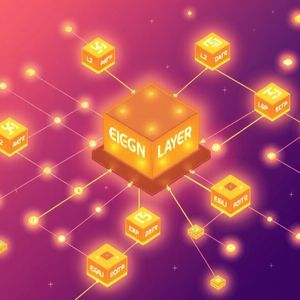EigenLayer Unleashes Revolutionary Multi-Chain Verification for AVS Expansion
7 min read
BitcoinWorld EigenLayer Unleashes Revolutionary Multi-Chain Verification for AVS Expansion The blockchain world is constantly evolving, seeking new ways to enhance security, scalability, and interoperability. At the forefront of this innovation is EigenLayer , a groundbreaking protocol that has already reshaped how developers think about shared security on Ethereum. Now, EigenLayer is taking a monumental leap forward with the introduction of multi-chain verification, promising to expand its revolutionary Actively Validated Services (AVSs) far beyond the confines of Ethereum Layer-1. This development isn’t just an upgrade; it’s a paradigm shift for decentralized applications, offering unprecedented flexibility and security across a diverse ecosystem of blockchains. What is EigenLayer ‘s Multi-Chain Verification and Why Does It Matter? Traditionally, AVSs built on EigenLayer have leveraged Ethereum’s robust security by requiring restakers to validate their services directly on the Layer-1 blockchain. While incredibly secure, this approach limited the operational scope of these services. The new multi-chain verification feature fundamentally alters this dynamic. It allows AVSs to deploy and operate seamlessly on Layer-2 networks, such as Coinbase’s Base, and even other independent blockchains, all while continuing to benefit from the shared security guarantees provided by EigenLayer ’s extensive network of restakers. This innovation matters immensely because it addresses a critical need in the blockchain space: interoperability and scalability without compromising security. By enabling AVSs to transcend a single chain, EigenLayer is fostering a more interconnected and efficient decentralized ecosystem. Imagine decentralized oracles, data availability layers, or bridge services that can operate with the same high level of security across various chains, tailored to specific needs and user bases. This is the promise of EigenLayer ‘s multi-chain future. The Core Mechanics: How Does EigenLayer Achieve Shared Security Across Chains? At its heart, EigenLayer ‘s shared security model relies on ‘restaking.’ Ethereum validators, who already stake their ETH to secure the Ethereum network, can ‘restake’ their staked ETH (or liquid staking tokens) to additionally secure AVSs. This mechanism provides AVSs with cryptoeconomic security far exceeding what they could achieve individually, as any malicious behavior by a restaker would result in their staked ETH being ‘slashed’ – a powerful deterrent. Extending this robust security to multiple chains required innovative engineering. EigenLayer ‘s multi-chain verification works by allowing AVSs deployed on a Layer-2 or another blockchain to still register with the main EigenLayer contract on Ethereum Layer-1. The restakers continue to perform their validation duties on Ethereum, but their attestations and slashing conditions are designed to reflect the state and actions occurring on the remote chain where the AVS is operating. This creates a secure bridge, ensuring that the integrity of the AVS, regardless of its deployment location, is continuously monitored and enforced by the powerful economic guarantees of EigenLayer . A tangible example of this in action is the recent launch on the Sepolia testnet of Base, Coinbase’s Layer-2 network. This pilot demonstrates how AVSs can leverage Base’s scalability and lower transaction costs while still relying on EigenLayer for foundational security. This testnet phase is crucial for refining the mechanisms before a full mainnet rollout and broader chain support, which are anticipated in the coming months. Unlocking New Possibilities: Benefits of Expanded AVS Deployment with EigenLayer The implications of EigenLayer ‘s multi-chain verification are far-reaching, promising significant advantages for various stakeholders: For Developers and Builders: Developers gain unprecedented flexibility. They are no longer tethered to Ethereum L1’s gas fees and throughput limitations for their AVSs. They can deploy on L2s for better user experience, or even on application-specific blockchains, while still inheriting EigenLayer ‘s security. This unlocks a vast canvas for innovation, allowing them to build more specialized and efficient decentralized services. For Users: Users will benefit from more diverse, efficient, and cost-effective decentralized applications. Services leveraging AVSs can offer faster transactions, lower fees, and improved responsiveness, enhancing the overall user experience across different blockchain environments. This could lead to a new generation of highly performant dApps that feel more like traditional web applications. For the Broader Blockchain Ecosystem: This move significantly boosts interoperability. By enabling AVSs to secure services across multiple chains, EigenLayer acts as a foundational layer for a truly interconnected blockchain future. It reduces the need for bespoke security solutions for each chain, fostering a more unified and secure Web3 landscape. This could accelerate the adoption of decentralized technologies by making them more accessible and robust. What Challenges Might EigenLayer Face in This Expansion? While the vision is compelling, expanding EigenLayer ‘s reach across multiple chains is not without its complexities. Several challenges need careful navigation: Technical Integration Complexity: Integrating with a diverse array of Layer-2s and other blockchains, each with its unique architecture and consensus mechanisms, presents significant technical hurdles. Ensuring seamless communication and consistent security enforcement across all these environments will require continuous development and rigorous auditing. Security Vulnerabilities: Introducing new interfaces and cross-chain interactions inherently expands the attack surface. While EigenLayer ‘s core security model is robust, the nuances of multi-chain operation demand meticulous attention to potential vulnerabilities that could arise from bridging or inter-chain communication protocols. Adoption and Network Effects: The success of multi-chain verification heavily relies on widespread adoption by both AVS developers and restakers. Convincing new projects to build on EigenLayer ‘s multi-chain framework, and ensuring sufficient restaker participation across various chains, will be an ongoing effort. Regulatory Scrutiny: As blockchain technology evolves and gains mainstream traction, regulatory bodies are increasing their oversight. Cross-chain operations, especially those involving shared security, might attract additional scrutiny regarding compliance, accountability, and systemic risk. The Road Ahead: What’s Next for EigenLayer and Multi-Chain Adoption? The successful deployment on the Sepolia testnet is merely the first step. The coming months are poised to bring a full mainnet rollout of EigenLayer ‘s multi-chain verification, alongside support for a wider array of Layer-2 networks and potentially other prominent blockchains. This phased approach allows Eigen Labs to meticulously test, refine, and optimize the system for maximum security and efficiency. Looking further ahead, this expansion positions EigenLayer as a foundational middleware layer for the entire decentralized web. Its ability to provide robust, shared security across disparate blockchain environments could accelerate the development of truly interoperable dApps and protocols. This could lead to a future where users interact with services without needing to understand which underlying chain they are on, creating a much more seamless and integrated blockchain experience. Developers should keep a close eye on EigenLayer ‘s updates, as this innovation is set to redefine the boundaries of what’s possible in decentralized computing. EigenLayer ‘s introduction of multi-chain verification marks a pivotal moment in the evolution of blockchain technology. By enabling Actively Validated Services to extend their operations beyond Ethereum Layer-1 while retaining the formidable security guarantees of restaking, EigenLayer is not just scaling its own ecosystem; it’s paving the way for a more secure, interconnected, and flexible decentralized future. This strategic move solidifies EigenLayer ‘s position as a critical innovator, empowering developers and users alike to unlock the full potential of a truly multi-chain world. The journey has just begun, and the implications for Web3 are profound. Frequently Asked Questions (FAQs) Q1: What is multi-chain verification in the context of EigenLayer ? A1: Multi-chain verification is a new feature by Eigen Labs that allows Actively Validated Services (AVSs) built on EigenLayer to deploy and operate on various Layer-2 networks and other blockchains, instead of being limited to Ethereum Layer-1. They still leverage EigenLayer ‘s shared security model. Q2: How does EigenLayer maintain security for AVSs deployed on other chains? A2: EigenLayer maintains security by having restakers (Ethereum validators who have restaked their ETH) continue to perform validation duties on Ethereum Layer-1. Their attestations and slashing conditions are designed to reflect the state and actions of the AVS on the remote chain, ensuring cryptoeconomic security across networks. Q3: Which networks currently support EigenLayer ‘s multi-chain verification? A3: Multi-chain verification is currently live on the Sepolia testnet of Base, Coinbase’s Layer-2 network. A full mainnet rollout and broader chain support for various Layer-2s and other blockchains are expected in the coming months. Q4: What are the main benefits of this new feature for developers and users? A4: For developers, it offers greater flexibility to deploy AVSs on scalable and cost-effective Layer-2s or other chains. For users, it means access to more efficient, faster, and cheaper decentralized applications that benefit from EigenLayer ‘s robust security across multiple blockchain environments. Q5: What challenges might EigenLayer face with multi-chain expansion? A5: Challenges include technical integration complexities with diverse blockchain architectures, managing increased security vulnerabilities from cross-chain interactions, ensuring widespread adoption by both AVS developers and restakers, and navigating potential regulatory scrutiny. Found this article insightful? Share it with your network and help spread the word about EigenLayer ‘s groundbreaking multi-chain verification. Let’s discuss how this innovation will shape the future of decentralized applications! To learn more about the latest blockchain scaling trends, explore our article on key developments shaping Ethereum interoperability . This post EigenLayer Unleashes Revolutionary Multi-Chain Verification for AVS Expansion first appeared on BitcoinWorld and is written by Editorial Team

Source: Bitcoin World



